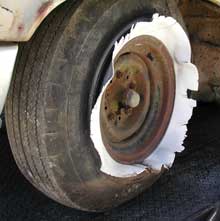Port-o-Walls
Wayne Graefen collects interesting stuff. He just bought a whole car in order to get a set of vintage Port-o-Walls. If you're around my age you remember Port-o-Walls; you probably even had them on one of your cars. Port-o-Walls were rings of white rubber that attached to your blackwall tires to make them look like whitewalls, without the expense of actually buying new tires. You simply deflated your tire, broke the bead, and stuffed the Port-o-Wall between the tire and the rim. Re-inflated, voila, your tires looked like genuine whitewalls, the rings now held on by tire pressure.
You could buy Port-o-Walls at Western Auto or Pep Boys or from the ubiquitous J.C. Whitney catalog, which good customers received about once a week. J.C. Whitney sold them for $3.95 a set. For $7.95 you could get them in genuine butyl rubber, which wouldn't turn yellow after a few months. If you didn't have $3.95 you could buy a kit of white rubber to paint your whitewalls on. Despite what the catalog said, they were not so good with tubeless tires, but by that time real whitewalls had come down in price and increased in availability.
One of the first things I did when I started driving the family Nash Rambler was to put on a set of Port-o-Walls. The car had always looked rather drab without them. When I bought my '40 DeSoto I got a set for it, too, although by the time this picture was taken I had removed them to put on my friend Tod's '36 Plymouth: They were portable, after all... (The red wheels on the DeSoto look odd without whitewalls. With the Port-o-Walls I thought they looked nifty. I got the idea from a 1950 Buick, which used a similar accent scheme.)
Chrysler Corporation used another approach to whitewalls after World War II. Many Mopars came with metal whitewalls ("spats?") that were held on like a wheel cover. Smaller in diameter than real whitewalls or Port-o-Walls, they provided a nice accent to the car. To my mind, a correctly-restored 1946-48 Chrysler should have them.

